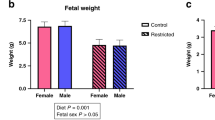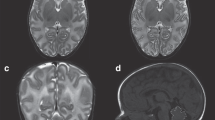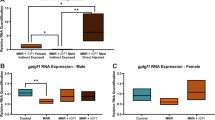Abstract
Background
We determined whether maternal nutrient restriction (MNR) in guinea pigs leading to fetal growth restriction (FGR) impacts cell death in the brain with implications for neurodevelopmental adversity.
Methods
Guinea pigs were fed ad libitum (Control) or 70% of the control diet before pregnancy, switching to 90% at mid-pregnancy (MNR). Fetuses were necropsied near term and brain tissues processed for necrosis (H&E), apoptosis (TUNEL), and pro- (Bax) and anti- (Bcl-2 and Grp78) apoptotic protein immunoreactivity.
Results
FGR-MNR fetal and brain weights were decreased 38% and 12%, respectively, indicating brain sparing but with brains still smaller. While necrosis remained unchanged, apoptosis was increased in the white matter and hippocampus in the FGR brains, and control and FGR-related apoptosis were increased in males for most brain areas. Bax was increased in the CA4 and Bcl-2 was decreased in the dentate gyrus in the FGR brains supporting a role in the increased apoptosis, while Grp78 was increased in the FGR females, possibly contributing to the sex-related differences.
Conclusions
MNR-induced FGR results in increased brain apoptosis with regional and sex-related differences that may contribute to the reduction in brain area size reported clinically and increased risk in FGR males for later neurodevelopmental adversity.
Similar content being viewed by others
Log in or create a free account to read this content
Gain free access to this article, as well as selected content from this journal and more on nature.com
or
References
Miller, S. L., Huppi, P. S. & Mallard, C. The consequences of fetal growth restriction on brain structure and neurodevelopmental outcome. J. Physiol. 594, 807–823 (2016).
Malhotra, A. et al. Detection and assessment of brain injury in the growth-restricted fetus and neonate. Pediatr. Res. 82, 184–193 (2017).
Resnick, R. & Creasy, R. K. in Maternal-Fetal Medicine 7th edn (eds Creasy, R. K. et al.) pp. 743–755 (Elsevier Sauders, Philadelphia, PA, 2014).
Grantham-McGregor, S. & Baker-Henningham, H. Review of the evidence linking protein and energy to mental development. Public Health Nutr. 8(7A), 1191–1201 (2005).
Crozier, S. R., Robinson, S. M., Godfrey, K. M., Cooper, C. & Inskip, H. M. Women’s dietary patterns change little from before to during pregnancy. J. Nutr. 139, 1956–1963 (2009).
Rees, S., Harding, R. & Walker, D. An adverse intrauterine environment: implications for injury and altered development of the brain. Int. J. Dev. Neurosci. 26, 3–11 (2008).
Basilious, A., Yager, J. & Fehlings, M. G. Neurological outcomes of animal models of uterine artery ligation and relevance to human intrauterine growth restriction: a systematic review. Dev. Med. Child Neurol. 57, 420–430 (2015).
Lafeber, H. N., Rolph, T. P. & Jones, C. T. Studies on the growth of the fetal guinea pig. The effects of ligation of the uterine artery on organ growth and development. J. Dev. Physiol. 6, 441–459 (1984).
Turner, A. J. & Trudinger, B. J. A modification of the uterine artery restriction technique in the guinea pig fetus produces asymmetrical ultrasound growth. Placenta 30, 236–240 (2009).
Elias, A. A., Ghaly, A., Matushewski, B., Regnault, T. R. & Richardson, B. S. Maternal nutrient restriction in guinea pigs as an animal model for inducing fetal growth restriction. Reprod. Sci. 23, 219–227 (2016).
McCarthy, M. M., Arnold, A. P., Ball, G. F., Blaustein, J. D. & De Vries, G. J. Sex differences in the brain: the not so inconvenient truth. J. Neurosci. 32, 2241–2247 (2012).
Bao, A. M. & Swaab, D. F. Sex differences in the brain, behavior, and neuropsychiatric disorders. Neuroscientist 16, 550–565 (2010).
Carter, A. M. Animal models of human placentation-a review. Placenta 28(Suppl A), S41–S47 (2007).
Elias, A. A. et al. Maternal nutrient restriction in guinea pigs leads to fetal growth restriction with evidence for chronic hypoxia. Pediatr. Res. 82, 141–147 (2017).
Roberts, C. T. et al. Maternal food restriction reduces the exchange surface area and increases the barrier thickness of the placenta in the guinea-pig. Placenta 22, 177–185 (2001).
Kind, K. L. et al. Chronic maternal feed restriction impairs growth but increases adiposity of the fetal guinea pig. Am. J. Physiol. Regul. Integr. Comp. Physiol. 288, R119–R126 (2005).
Nevin, C. L. et al. Maternal nutrient restriction in guinea pigs as an animal model for studying growth-restricted offspring with postnatal catch-up growth. Am. J. Physiol. Regul. Integr. Comp. Physiol. 314, R647–R654 (2018).
Economides, D. L. & Nicolaides, K. H. Blood glucose and oxygen tension levels in small-for-gestational-age fetuses. Am. J. Obstet. Gynecol. 160, 385–389 (1989).
Kramer, M. S. et al. Determinants of fetal growth and body proportionality. Pediatrics 86, 18–26 (1990).
Godfrey, K. & Robinson, S. Maternal nutrition, placental growth and fetal programming. Proc. Nutr. Soc. 57, 105–111 (1998).
Banasiak, K. J., Xia, Y. & Haddad, G. G. Mechanisms underlying hypoxia-induced neuronal apoptosis. Prog. Neurobiol. 62, 215–249 (2000).
Scott, R. J. & Hegyi, L. Cell death in perinatal hypoxic-ischaemic brain injury. Neuropathol. Appl. Neurobiol. 23, 307–314 (1997).
Liu, D., Zhang, M. & Yin, H. Signaling pathways involved in endoplasmic reticulum stress-induced neuronal apoptosis. Int. J. Neurosci. 123, 155–162 (2013).
Lee, A. S. The ER chaperone and signaling regulator GRP78/BiP as a monitor of endoplasmic reticulum stress. Methods 35, 373–381 (2005).
Piorkowska, K. et al. Synaptic development and neuronal myelination are altered with growth restriction in fetal Guinea pigs. Dev. Neurosci. 36, 465–476 (2014).
Jansson, T. & Persson, E. Placental transfer of glucose and amino acids in intrauterine growth retardation: studies with substrate analogs in the awake guinea pig. Pediatr. Res. 28, 203–208 (1990).
Rocha, E., Hammond, R. & Richardson, B. Necrotic cell injury in the preterm and near-term ovine fetal brain after intermittent umbilical cord occlusion. Am. J. Obstet. Gynecol. 191, 488–496 (2004).
Wong, M. K., Nicholson, C. J., Holloway, A. C. & Hardy, D. B. Maternal nicotine exposure leads to impaired disulfide bond formation and augmented endoplasmic reticulum stress in the rat placenta. PLoS ONE 10, e0122295 (2015).
Richardson, B. S. in Clinics in Perinatology (ed. Manning, F.) pp. 595–611 (WB Saunders Co., Philadelphia, 1989).
Keunen, H., Blanco, C. E., van Reempts, J. L. & Hasaart, T. H. Absence of neuronal damage after umbilical cord occlusion of 10, 15, and 20 min in midgestation fetal sheep. Am. J. Obstet. Gynecol. 176, 515–520 (1997).
Schmued, L. C., Albertson, C. & Slikker, W. Jr. Fluoro-Jade: a novel fluorochrome for the sensitive and reliable histochemical localization of neuronal degeneration. Brain Res. 751, 37–46 (1997).
Astrup, J. Energy-requiring cell functions in the ischemic brain. Their critical supply and possible inhibition in protective therapy. J. Neurosurg. 56, 482–497 (1982).
Kaneko, M., White, S., Homan, J. & Richardson, B. Cerebral blood flow and metabolism in relation to electrocortical activity with severe umbilical cord occlusion in the near-term ovine fetus. Am. J. Obstet. Gynecol. 188, 961–972 (2003).
Blaschke, A. J., Staley, K. & Chun, J. Widespread programmed cell death in proliferative and postmitotic regions of the fetal cerebral cortex. Development 122, 1165–1174 (1996).
Duncan, J. R., Cock, M. L., Harding, R. & Rees, S. M. Relation between damage to the placenta and the fetal brain after late-gestation placental embolization and fetal growth restriction in sheep. Am. J. Obstet. Gynecol. 183, 1013–1022 (2000).
Guo, R. et al. Brain injury caused by chronic fetal hypoxemia is mediated by inflammatory cascade activation. Reprod. Sci. 17, 540–548 (2010).
Dong, Y. et al. Chronic fetal hypoxia produces selective brain injury associated with altered nitric oxide synthases. Am. J. Obstet. Gynecol. 204, 254.e16–28 (2011).
Evans, L. C., Liu, H. & Thompson, L. P. Differential effect of intrauterine hypoxia on caspase 3 and DNA fragmentation in fetal guinea pig hearts and brains. Reprod. Sci. 19, 298–305 (2012).
Mallard, E. C., Williams, C. E., Johnston, B. M. & Gluckman, P. D. Increased vulnerability to neuronal damage after umbilical cord occlusion in fetal sheep with advancing gestation. Am. J. Obstet. Gynecol. 170(1 Pt 1), 206–214 (1994).
Weis, S. N. et al. Autophagy in the brain of neonates following hypoxia-ischemia shows sex- and region-specific effects. Neuroscience 256, 201–209 (2014).
Renolleau, S., Fau, S. & Charriaut-Marlangue, C. Gender-related differences in apoptotic pathways after neonatal cerebral ischemia. Neuroscientist 14, 46–52 (2008).
Charriaut-Marlangue, C., Besson, V. C. & Baud, O. Sexually dimorphic outcomes after neonatal stroke and hypoxia-ischemia. Int J. Mol. Sci. 19, pii: E61 (2017).
Hracsko, Z., Orvos, H., Novak, Z., Pal, A. & Varga, I. S. Evaluation of oxidative stress markers in neonates with intra-uterine growth retardation. Redox Rep. 13, 11–16 (2008).
Acknowledgements
We thank Dr Lin Zhao for support with the protein analysis, and Ms Jennifer Ryder for assistance with the manuscript. Supported by grants from the Children’s Health Research Institute and Department of Obstetrics and Gynecology, The University of Western Ontario, London, Canada (B.S.R., R.H.)
Author information
Authors and Affiliations
Contributions
The authors contributed to all three aspects of the Pediatric Research criteria.
Corresponding author
Ethics declarations
Competing interests
B.S.R. is the recipient of a Canada Research Chair Tier 1 in Fetal and Neonatal Health and Development. All the remaining authors declare no competing interests.
Additional information
Publisher’s note: Springer Nature remains neutral with regard to jurisdictional claims in published maps and institutional affiliations.
Rights and permissions
About this article
Cite this article
Ghaly, A., Maki, Y., Nygard, K. et al. Maternal nutrient restriction in guinea pigs leads to fetal growth restriction with increased brain apoptosis. Pediatr Res 85, 105–112 (2019). https://doi.org/10.1038/s41390-018-0230-6
Received:
Revised:
Accepted:
Published:
Issue date:
DOI: https://doi.org/10.1038/s41390-018-0230-6
This article is cited by
-
Downregulation of insulin receptor isoform A in the forebrain of fetal growth-restricted rats
Pediatric Research (2025)
-
Advances in prenatal imaging of brain abnormalities associated with fetal growth restriction: a review
Chinese Journal of Academic Radiology (2025)
-
Mid-Pregnancy Placental Transcriptome in a Model of Placental Insufficiency with and without Novel Intervention
Reproductive Sciences (2025)
-
Maternal Uterine Artery Adenoviral Vascular Endothelial Growth Factor (Ad.VEGF-A165) Gene Therapy Normalises Fetal Brain Growth and Microglial Activation in Nutrient Restricted Pregnant Guinea Pigs
Reproductive Sciences (2024)
-
Sex-Selective Increase of IGF-2 Expression in the Hypoxic Guinea Pig Placenta of Growth-Restricted Fetuses
Reproductive Sciences (2022)



